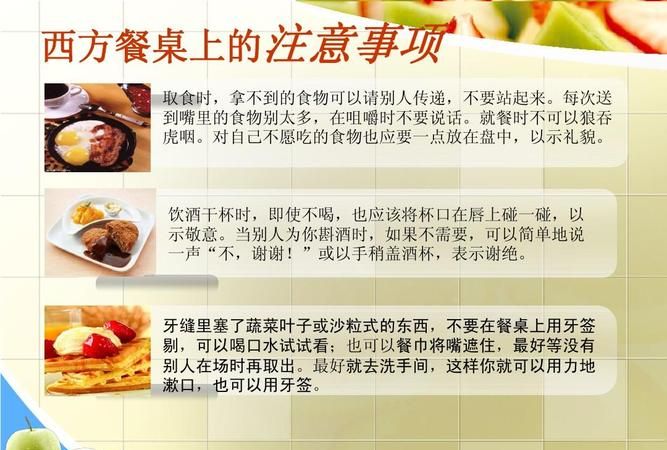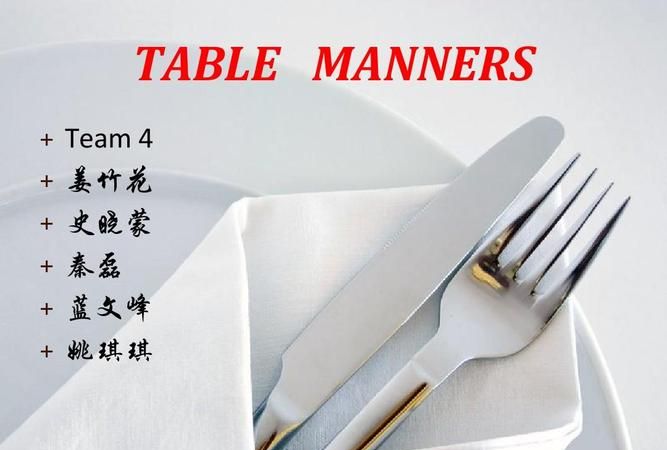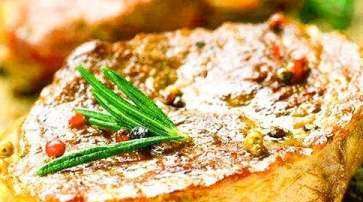本文目录
西方就餐礼仪英文

就餐礼仪英文
1.Pull out chairs to seat the women when you are eating together.
进餐时帮助女士入座。
2.Do not sit down before all the ladies are seated.
在女士未入座之前不要抢先入座。
3.Pull your chair up and sit clos
e to the table after sitting down.
入座后将椅子靠近餐桌。
4.It is customary to say grace before the meal begins in many Christian homes. Watch the host or hostess. If they bow their heads, join them.
很多__家庭进餐前有祷告的习惯。注意观察主人或主妇,如果他们低下头去,你也应随从他们。
5.When the hostess takes her napkin, open your napkin in half and lay it across your lap.
女主人拿起餐巾时,你也应拿起餐巾,打开一半,摊放在膝盖上。
6.When eating with silverware, begin from the outside piece, then knife and fork for the second course and so on. The pieces closest to the plate are for the last course.
使用餐具吃饭时,首先从最外侧开始,刀和叉是用来吃第二道菜及以后的菜的。最靠近盘子的餐具要留到最后用。
7.When having soup, move the spoon away from you to spoon out the soup. When a little remains, you may raise slightly the side of the bowl close to you.
用匙舀汤时,匙要从里往外舀。汤快喝完了时,可将汤盘近身一侧抬高一点。
8. Cut large pieces of food, such as steak or chops, into small pieces all at one time.
把大块食物,如牛排或排骨,一次切成若干小块。
9. Use you knife close to the fork. This way, it is a lot easier to cut meat.
刀要靠近叉使用,这样更容易切割。
10. Put your knife and fork diagonally on the further side of the plate when you have finished eating something. Do not place them leaning on the plate. The knife should always be placed the sharp edge in.
吃完东西时将刀叉对角放齐,置于盘子外侧。不要靠在盘子上,而且刀刃应该向里。
11. In在美国,切完东西时,你可以放下刀,用右手拿起叉来吃饭;在欧洲,你可以左手拿叉,用叉的背面将食物送到嘴里,这样有利于叉的边缘放较硬的食物,上面再放较软的食物。
12.You can choose whichever you like.
你可以自由选择你喜欢的食物。
各国用餐礼仪大不同
1. SEATING ETIQUETTE
Your host may have seating arrangements in mind, so you should allow him to direct you to your seat. As the host, you should suggest the seating arrangements. In a restaurant, the guest of honor should sit in the best seat at the table. Usually that is one with the back of the chair to the wall. Once the guest of honor's seat is determined, the host should sit to her left. Other people are then offered seats around the table.
在中国,大家都习惯进去一家餐厅直接坐下来等服务员来点餐。在美国一般都在前台,有的时候人多,就在门口等waiter or waitress来带你入座。
2. NAPKIN ETIQUETTE
At informal meals, place the napkin in your lap immediately upon seating. During formal occasions, before unfolding the napkin, wait for the hostess to remove her napkin from the table and unfold it in her lap.
Read more table manners tips for using your napkin in the napkin etiquettesection.
我们小时候看电视,外国人都把餐巾塞在领口。然而,在美国,餐巾是放在大腿上的。
3. FOOD SERVICE ETIQUETTE
During service of a formal dinner, the food is brought to each diner at the table; the server presents the platter or bowl on the diner's left. At a more casual meal, either the host dishes the food onto guests' plates for them to pass around the table or the diners help themselves to the food and pass it to others as necessary.
在国内,大家都是一起吃。在美国则是分餐制。每个人吃自己盘子里的,偶尔前菜大家会分着吃。所以服务员会是不是问你吃好了没有。如果你说你吃完了,服务员就会把你的菜撤走,即使你只吃了一口。。。
4. THE TABLE SETTING
Deciding which knife, fork, or spoon to use is made easier by the outside-in table manners rule – using utensils on the outside first and working your way inward.
餐具的使用顺序有点复杂,比如吃沙拉的刀叉和吃牛排正餐的刀叉是不一样的。喝汤和吃甜品的勺子也是不一样的。基本上从大小就可以分辨。但是小旋子觉得与其记这么复杂的东西,不如在用餐的时候,很礼貌的问服务员:It's my first time to dine in a high end restaurant. I am so confused about all these table settings. Can you please tell me which one I should start with?
5. WHEN TO START EATING
At a small table of only two to four people, wait until everyone else has been served before starting to eat. At a formal or business meal, you should either wait until everyone is served to start or begin when the host asks you to.
咱们国内的风俗也是差不多,等人齐了再点菜,再开动。美国是,等每个人各自点的菜都上齐了,再开动。
6. HANDLING UTENSILS
The continental table manners style prevails at all meals, formal and informal, because it is a natural, non-disruptive way to eat.
Hold your fork in your left hand, tines downward.
Hold your knife in your right hand, an inch or two above the plate.
Extend your index finger along the top of the blade.
Use your fork to spear and lift food to your mouth.
If your knife is not needed, it remains on the table.
7. PASSING THE FOOD
Pass to the right. One diner either holds the dish as the next diner takes some food, or he hands it to the person, who then serves herself. Any heavy or awkward dishes are put on the table with each pass. Special rules apply topassing salt and pepper and passing bread and butter.
美国人聚餐一般不share.但如果是家庭或者亲朋好友聚餐,大家还是会分享自己的食物的。
8. RESTING UTENSILS
When you pause to take a sip of your beverage or to speak with someone, rest your utensils by placing your knife and fork on your plate near the center, slightly angled in an inverted V and with the tips of the knife and fork pointing toward each other.
9. MEALS END
At a formal affair, plates are removed by a professional staff. But as most informal meals are served without help, the hostess clears the plates, often with the help of a guest or two. At a family meal, members clear their own plates.
8和9一起说。尤其在餐厅用餐时,当我们中途去洗手间和我们吃完了的时候,餐具的摆放是不一样的。很多朋友第一次在美国吃西餐,去了一趟洗手间,回来的时候自己的食物已经被收走。为了避免这样的悲剧,请看下图:
10. GET THE BILL
After you and your friends finish your food, you can go ahead and get your bill. Just say to the waiter/waitress: Check, please./Can/May I please have my check/bill?
中国是没有给小费的习惯。但是在美国,几乎在任何服务业都要给小费。快餐店除外。小费给多少,不同城市,不同州,最低标准都会不一样。详细的请自行百度Google. 还是那句话,如果是在美国的普通餐厅用餐,不要太在意。但是如果去领导,教授的家里用餐,以上的很多细节到家千万不要忘了哦!
中西方餐桌礼仪差异英语作文
The Differences Between Chinese and Western Table Manners/etiquette
Comparison of Chinese and western Table Manners/etiquette
table manners
UK [ˈteɪbl mænəz]
US [ˈteɪbl mænərz]
n.
餐桌规矩;进餐礼节
table etiquette
UK [ˈteɪbl ˈetɪkət]
US [ˈteɪbl ˈetɪkət]
餐桌礼仪
manners是常使用复数形式,指非常普通的、连孩子都应掌握的基本的礼仪规范;etiquette则更为讲究,要比manners复杂,常随着形势的变化而改变。
Etiquette (来自法语)and manners are synonyms, but do have slightly different meanings.
Etiquette is a code of polite conduct based on social acceptance and efficiency. Simply, it means to follow rules for efficiently or politeness. Sometimes, rules of etiquette are archaic (old-fashioned) and don't make sense nowadays.
For example, it is good etiquette to sit with your back straight.
It is good etiquette to not chew loudly when at the dinner table.
It is good etiquette to dress neatly for a formal occasion.
Etiquette may change in different cultures. For example, it could be good etiquette to chew loudly when eating your food (this is just an example, haha).
Manners are polite behaviors that reflect an attitude of consideration, kindness and respect for others.
For example, saying "please" and "thank you" are good manners. Saying "excuse me" if you need to get someone's attention instead of shouting rudely is good manners. Not interrupting someone while they are talking is good manners.
Good manners are usually universal and don't change in different cultures.
Of course, the main difference on the Chinese dinner table is chopsticks instead of knife and fork, but that's only superficial. Besides, in decent restaurants, you can always ask for a pair of knife and fork, if you find the chopsticks not helpful enough.
tableware
UK [ˈteɪblweə(r)]
US [ˈteɪblwer]
n.
(商店用语)餐具
chopsticks
UK [ˈtʃɒpstɪks]
US [ˈtʃɑpˌstɪks]
n.
筷子
chopstick的复数
The real difference is that in the West, you have your own plate of food, while in China the dishes are placed on the table and everyone shares ,Perhaps it’s one of the things that surprises a Western visitor most is that some of the Chinese hosts like to put food onto the plates of their guests. In formal dinners, there are always "public" chopsticks and spoons for this purpose, but some hosts may use their own chopsticks. This is a sign of genuine friendship and politeness. It is always polite to eat the food. If you do not eat it, just leave the food in the plate.
People in China tend to over-order food, for they will find it embarrassing if all the food is consumed. When you have had enough, just say so. Or you will always overeat!
Chinese table manners of families have no intrinsic quality even there are different region and position. No matter three meals a day or guest's arrival, always bowls with chopsticks, food with soup. There is no rule for how to put the tableware. What people care about more are not the gorgeous tableware but the sumptuous food. People's dining position reflects the most obvious etiquette of Chinese table manners. In ancient society, men are supreme, and women are not allowed to sit with men on the same table. Although this is modern society, this kind of ancient etiquette still remains. Today in China, the phenomenon that men sit on the table before women can be found everywhere. The master of a family usually sits on the first-class seat. The first-class seat is usually near the interior of a room facing to the door. Once there is a guest, the master will offer the first-class seat to the guest politely. If it is an ordinary meal of family, families should start after the elder. If there is a guest, the master offer the food to the guest is essential from the beginning to the end. And the tradition of urging others to drink is also a special phenomenon.
Here are some characteristics on Chinese eating:
The real difference is that in the West, you have your own plate of food, while in China the dishes are placed on the table and everyone shares ,Perhaps it’s one of the things that surprises a Western visitor most is that some of the Chinese hosts like to put food onto the plates of their guests. In formal dinners, there are always "public" chopsticks and spoons for this purpose, but some hosts may use their own chopsticks. This is a sign of genuine friendship and politeness. It is always polite to eat the food. If you do not eat it, just leave the food in the plate.
People in China tend to over-order food, for they will find it embarrassing if all the food is consumed. When you have had enough, just say so. Or you will always overeat!
Chinese table manners of families have no intrinsic quality even there are different region and position. No matter three meals a day or guest's arrival, always bowls with chopsticks, food with soup. There is no rule for how to put the tableware. What people care about more are not the gorgeous tableware but the sumptuous food. People's dining position reflects the most obvious etiquette of Chinese table manners. In ancient society, men are supreme, and women are not allowed to sit with men on the same table. Although this is modern society, this kind of ancient etiquette still remains. Today in China, the phenomenon that men sit on the table before women can be found everywhere. The master of a family usually sits on the first-class seat. The first-class seat is usually near the interior of a room facing to the door. Once there is a guest, the master will offer the first-class seat to the guest politely. If it is an ordinary meal of family, families should start after the elder. If there is a guest, the master offer the food to the guest is essential from the beginning to the end. And the tradition of urging others to drink is also a special phenomenon.
Here are some characteristics on Chinese eating:
Can I take your order now?
Will you have some soup before the meat course?
吃荤菜前先来点汤好吗?
关于宴会知多少?
banquet
UK [ˈbæŋkwɪt]
US [ˈbæŋkwɪt]
n.
宴会;盛宴;筵席
CET6 · 考研 · TEM8 · GRE · TOEIC
复数:banquets
The state banquet国宴
SITTING
In China, any banquet, only will have one form, will be everybody sits in a circle all round. The banquet must use the round table, this formally has created (营造)one kind of unity, politeness, altogether the interest atmosphere. The delicacy delicacies place(摆放) a table of person's center, it is not only the object which table of people appreciate, taste, is also a table of person sentiment exchange intermedium.
Westerners treat with a long table, men and women sit in the owner at both ends,(男女主人坐在两头) and then the guest of honor men and women in the press and the general order of the guests seating arrangements.
关键词:
a circle
UK [ə ˈsɜːkl]
US [ə ˈsɜːrkl]
一周;一圈
all around
UK [ˌɔːl əˈraʊnd]
US [ˌɔːl əˈraʊnd]
各方面,四周
the round table
UK [ðə raʊnd ˈteɪbl]
US [ðə raʊnd ˈteɪbl]
圆桌
round-table conference
UK [raʊnd ˈteɪbl ˈkɒnfərəns]
US [raʊnd ˈteɪbl ˈkɑːnfərəns]
圆桌会议;举行圆桌会议
圆桌会议指围绕圆桌举行的会议,圆桌并没有主席位置,亦没有随从位置,人人平等。此概念源自英国传说里的亚瑟王与其圆桌骑士在卡默洛特时代的习俗。
圆桌会议是指一种平等、对话的协商会议形式。是一个与会者围圆桌而坐的会议。在举行国际或国内政治谈判时,为避免席次争执、表示参加各方地位平等起见,参加各方围圆桌而坐,或用方桌但仍摆成圆形。直到今天“圆桌会议”已成为平等交流、意见开放的代名词,也是国家之间以及国家内部,一种重要的协商和讨论形式。
a long table
the guests of honor贵宾
The order of dishes in the West(bread eater)
Dinner start with a small dish, which is often called an a starter. After the starter you will get a bowl of soup. The next dish is the main course, it usually is a beefsteak . A vegetable salad will be served. Then a delicious dessert will appear at the table . At last is a cup of tea or coffee.
Starter(英式)
UK [ˈstɑːtə(r)]
US [ˈstɑːrtər]
n.
(主菜之前的)开胃小吃,开胃品;参赛人;参赛的马(或汽车等);(赛跑等的)发令员
TEM8 Vocabulary
复数:starters
Appetizer(北美)
UK [ˈæpɪtaɪzə(r)]
US [ˈæpɪtaɪzər]
n.
(餐前的)开胃品,开胃饮料
GRE · TOEIC
复数:appetizers
The main course 主菜
The order of dishes in China (rice eater)
The meal usually begins with a set of at least four cold dishes, to be followed by the main courses of hot meat and vegetable dishes. Soup then will be served to be followed by staple food ranging from rice, noodles to dumplings. If you wish to have your rice to go with other dishes, you should say so in good time, for most of the Chinese choose to have the staple food at last or have none of them at all.
中文:渴汤 不等于英文drink soup 而是 eat soup.
This is my spoon. I like to eat soup.
这是我的勺子,我喜欢喝汤。
I eat soup with a large spoon.
我用大勺子喝汤。
Manners in the West
1) As soon as the hostess picks up her napkin, pick yours up and lay it on your lap. Sometimes a roll of bread is wrapped in it; if so, take it out and put it on your side plate.
2) The Soup Course
Dinner usually begins with soup. The largest spoon at your place is the soup spoon. lt will be beside your plate at the right-hand side.
3) The Fish Course
If there is a fish course, it will probably follow the soup. There may be a special fork for the fish, or it may be similar to the meat fork. Often it is smaller.
4) The Meat Course
The main Course is usually served by the host himself, especially if it is a fowl or a roast which need to be carved. He will often ask each guest what piece he prefers, and it is quite proper to state your preference as to lean or fat, dark (红肉 )or light (白肉) 。
5) Helping Yourself and Refusing
If a servant passes food around, he will pass the dish in at your left hand so that you can conveniently serve yourself with your right hand. Never serve yourself while the dish is on your right; it is then the turn of your neighbor on the right. It is polite to take some of everything that is passed to you. But if there is something you may not like, you may quietly say: No thank you。
6) Various rules and Suggestions
Sit up straight on your chair;
Do not put much food in your mouth at a time; Drink only when there is no food in your mouth; Try not to get into your mouth anything that will have to be taken out; Do not make any noise when you eat; Do not clean your teeth at the table or anywhere in public, either with your finger or a tooth pick/dental floss , not even with you tongue.
Receiving guests
When a guest receives an invitation to someone's home, it is common but not necessary for the guest to ask, "Could I bring anything?" If the host declines, the guest should not insist, as this insinuates that the host is unable to provide
中文:渴汤 不等于英文drink soup 而是 eat soup.
This is my spoon. I like to eat soup.
这是我的勺子,我喜欢喝汤。
I eat soup with a large spoon.
我用大勺子喝汤。
Manners in the West
1) As soon as the hostess picks up her napkin, pick yours up and lay it on your lap. Sometimes a roll of bread is wrapped in it; if so, take it out and put it on your side plate.
2) The Soup Course
Dinner usually begins with soup. The largest spoon at your place is the soup spoon. lt will be beside your plate at the right-hand side.
3) The Fish Course
If there is a fish course, it will probably follow the soup. There may be a special fork for the fish, or it may be similar to the meat fork. Often it is smaller.
4) The Meat Course
The main Course is usually served by the host himself, especially if it is a fowl or a roast which need to be carved. He will often ask each guest what piece he prefers, and it is quite proper to state your preference as to lean or fat, dark (红肉 )or light (白肉) 。
5) Helping Yourself and Refusing
If a servant passes food around, he will pass the dish in at your left hand so that you can conveniently serve yourself with your right hand. Never serve yourself while the dish is on your right; it is then the turn of your neighbor on the right. It is polite to take some of everything that is passed to you. But if there is something you may not like, you may quietly say: No thank you。
6) Various rules and Suggestions
Sit up straight on your chair;
Do not put much food in your mouth at a time; Drink only when there is no food in your mouth; Try not to get into your mouth anything that will have to be taken out; Do not make any noise when you eat; Do not clean your teeth at the table or anywhere in public, either with your finger or a tooth pick/dental floss , not even with you tongue.
Receiving guests
When a guest receives an invitation to someone's home, it is common but not necessary for the guest to ask, "Could I bring anything?" If the host declines, the guest should not insist, as this insinuates that the host is unable to provide adequate hospitality, especially for more formal situations . such as dinner parties. Hosts accepting such offers should be clear, but not demanding; if one does not think the guest will be able to provide the correct item, politely decline the offers. It is polite to announce your presence when arriving at an informal occasion, such as a backyard barbecue, or if dropping by unexpectedly, although the latter is a faux pas unless the host has previously indicated that such visits are welcome.
Guests wishing to give flowers should consider sending them earlier in the day or the day before a dinner party rather than bring them just as the hostess is busy with last minute dinner preparations. A host might keep a vase handy if he or she suspects that flowers, wile brought by guests.
A guest may offer to help a host, and it is more appropriate in more familiar situations. The host should turn down help offered by people he is less familiar with. Judith Martin
states: "A good guest offers to help but does not insist if the offer is firmly refused ". A good host never requests help and offers mild resistance if it is wanted, but firm resistance if it is not.
General standards
These etiquette topics are relevant in both the United States and Canada and pertain no basic interactions in society. It is a understood that these are general rules to which in certain contexts and depending on the expectations of the parties involved,
there may be exceptions.
Manners in China
1)Spitting Out the Bones
In China it is common practice to spit things out on the table or the floor. Often food has small pieces of bone or other inedible parts that need to be removed from the mouth. Using chopsticks, a hand or a tissue is a polite way around the problem.
2)Touching Tables
Though in the West it is sometimes considered rude to put one's elbows on the dining table, this is quite acceptable in China, particularly when eating noodles.
3)Noise and Smoking
Eating noisily is allowed in China. Slurping, smacking the lips and leaving the mouth open when eating can be viewed as demonstrating enjoyment of the food and a friendly atmosphere in China.
Smoking is also permitted in most Chinese restaurants. A way round this, in larger restaurants, is to request a side room you’re your meal, which will have its own door to insulate you from the noise and smoke.
4)Dessert
Eating something sweet for dessert is not a Chinese custom. Sweet things can be found hidden among everything else on a Chinese menu. Fruit salads and caramel covered apple are Chinese sweet dishes that are popular with Westerners.
5)Drinking
Beer is very popular in China. The other popular alcoholic drink is rice wine. Beware, this can be very strong .In China, drinking alcohol is still mainly a male custom. Male guests are routinely offered alcohol and, cigarettes at meal times. Just politely refuse if you don't want them. An empty glass is always refilled, no matter about protests is that the guest has had enough, as a mark of politeness or good will often a refusal has to be given three times.

西方餐桌礼仪规矩英文》2条
正规的西餐礼仪
Normal Etiquette in West Restaurant
1、预约的窍门。越高档的饭店越需要事先预约。预约时,不仅要说清人数和时间,也要表明是否要吸烟区或视野良好的座位。如果是生日或其他特别的日子,可以告知宴会的目的和预算。在预定时间内到达,是基本的礼貌。
1. Doohickey of Preengage. The more slap-up the restaurant is, the more necessary to preengage. When making a preengage, you have to tell the exact number of person and the time, but also show clearly if you want to a non-smoking or well viewing place. If it is for the birthday or any other special days, you can make them know the purpose and budget. It is bacical politeness that you should arrive in time.
2、再昂贵的休闲服,也不能随意穿着上餐厅。
2. you shouldn't wear the casual clothes in the restaurant even it may be a very expensive one.
3、吃饭时穿着得体是欧美人的常识。去高档的餐厅,男士要穿着整洁的上衣和皮鞋;女士要穿套装和有跟的鞋子。如果指定穿正式服装的话,男士必须打领带。
It is the common sense that one should wear properly when having dinner.
不好意思,现在有点事情要走开一下

西餐礼仪英文介绍简短
西餐礼仪英文简短版
现在很多人都有去吃西餐的习惯了,那么你知道西餐的礼仪英语要怎么说吗?下面是为大家准备的西餐礼仪英文简短,希望可以帮助大家!

西餐礼仪英文简短
utensils / cutlery
餐具
knife 刀子
fork 叉子
spoon 汤匙
plates 盘子
salad plate 沙拉盘
glasses 杯子
napkin 餐巾
pepper shaker 胡椒罐
salt shaker 盐罐
bread basket面包篮
butter tray 奶油碟
Seating
入座
1. Man should open the chair for the lady. 男士应该为女士拉开椅子让她入座。
2. Man should sit on the lady’s left-hand side. 男士应该坐在女士的`左手边。
3. Go into the seat from the left-side. 由椅子的左侧入座。
4. Keep your hands on the lap before the meal serving. 在上餐之前把手放在大腿上。
Napkin
餐巾使用方式
1. Unfold the napkin and fold it half before putting it on your lap. 打开餐巾,对折,然后放在大腿上。
2. Use the napkin only to wipe your mouth. 餐巾只能用来轻轻的擦拭嘴边。
3. Place the napkin on the back of the chair if you need to be excused. 如要离开座位, 将餐巾放在椅背上。
4. After completion, place the soiled napkin at the left of your place setting. 用餐完毕, 把用过的餐巾放在餐具的左手边。
Table manners
用餐礼仪
1. During eating, your back should be relying on the seat back. 用餐时,背部要靠着椅背。
2. The meat entrees should match wine, and the fish entrees should match white wine.主菜若是肉类应搭配红酒,鱼类则搭配白酒。
3. When eating the soup, scoop the soup with spoon from back to front. 喝汤时,用汤匙由后往前将汤舀起。
4. When eating the bread, torn the bread into small pieces and eat with left hand. 吃面包时,先用两手撕成小块,再用左手拿来吃。
Place Setting
餐具摆设与使用方法
1. Put the fork on the left-hand side and the knife on the right-hand side. 把叉子放在左边,刀子放在右边。
2. Always eat outside-in. 先用摆在最外面的刀叉,由外而内的使用餐具。
3. Put the salad fork to the outside of the dinner fork, the salad knife to the outside of the dinner knife. 把沙拉用叉子放在晚餐(主餐)叉的外侧,沙拉刀放在晚餐(主餐)刀外侧。因为我们是先吃沙拉再吃主餐。
4. The knife blade should be pointed toward the plate. 刀刃要面向盘子摆放。
5. The soup spoon goes outside the knives. 喝汤用的汤匙要放在刀子外侧。
6. Place the dessert up top, and the bowl of the spoon is pointing to the left. 把甜点餐具摆在餐盘正上方,汤匙的前端要朝左摆放。
7. Set a cake fork and flip it 180 degrees to dessert spoon. 蛋糕叉和甜点汤匙摆放方向相反。
8. The bread plate should be set at the upper left, and the butter knife goes on the plate at an angle, with the blade pointing in. 面包盘要摆在左上角,奶油刀要斜摆在面包盘上,让刀刃面向自己。
9. Set the wine glass to the upper right. 把酒杯放在右上角。
10. Place the water glass to the left of the wine glass. 把水杯斜放在酒杯左侧。
;以上就是关于关于西方就餐礼仪的英文单词 ,西方就餐礼仪英文的全部内容,以及关于西方就餐礼仪的英文单词 的相关内容,希望能够帮到您。
